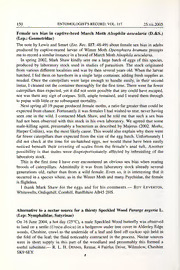
Alternative to a nectar source for a thirsty speckled wood Pararge aegeria L. (Lep: Nymphalidae, Satyrinae) PDF
Preview Alternative to a nectar source for a thirsty speckled wood Pararge aegeria L. (Lep: Nymphalidae, Satyrinae)
150 ENTOMOLOGIST'SRECORD,VOL. 117 25.vii.2005 Female sex bias in captive-bred March Moth Alsophila aescularia (D.&S.) (Lep.: Geometridae) The note by Lewis and Smart {Ent. Rec. Ill: 48-49) aboutfemale sex bias in adults produced by captive-reared larvae of Winter Moth Operophtera brumata prompts metorecordasimilarinstancein abroodofMarchMothAlsophilaaescularia. In spring 2002, Mark Shaw kindly sent me a large batch ofeggs ofthis species, produced by laboratory stock used in studies of parasitism. The stock originated from various different localities and was by then several years old. When the larvae hatched, I fed them on hawthorn in a single large container, adding fresh supplies as needed. Once the caterpillars were large enough to handle easily, in their second instar, I cleaned out the containerthoroughly forthe firsttime. There were farfewer caterpillars than expected, yet it did not seem possible that any could have escaped, nor was there any sign ofcorpses. Still, ample remained, and I reared them through topupaewithlittleorno subsequentmortality. Next spring all 19 pupae produced female moths, aratio fargreaterthan couldbe expectedfromchance. Fortunately itwas femalesIhadwishedtorear, neverhaving seen one in the wild. I contacted Mark Shaw, and he told me that such a sex bias had not been observed with this stock in his own laboratory. We agreed that some male-killing agent, presumably a bacterium as described by Majerus (2002. Moths, HarperCollins), was the most likely cause. This would also explain why there were far fewer caterpillars than expected from the size ofthe egg batch. Unfortunately I did not check at the time for un-hatched eggs, nor would these have been easily noticed beneath their covering of scales from the female's anal tuft. Another possibility is that males were disproportionately affected by inbreeding of the laboratory stock. This is the first time I have ever encountered an obvious sex bias when rearing broods of caterpillars. Admittedly it was from laboratory stock already several generations old, rather than from a wild female. Even so, it is interesting that it occurred in a species where, as in the Winter Moth and many Psychidae, the female isflightless. — I thank Mark Shaw for the eggs and for his comments. Roy Leverton, Whitewells, Ordiquhill, Comhill, BanffshireAB45 2HS. Alternative to a nectar source for a thirsty Speckled Wood Pararge aegeria L. (Lep: Nymphalidae,Satyrinae) On 16 June 2004, a hot day (25°C), a male Speckled Wood butterfly was observed to land on a nettle (Urtica dioica) in a hedgerow under tree cover in Alderley Edge woods, Cheshire, crawl to the underside of a leaf and feed offcuckoo spit held in the fold of the leaf; the fluid noticeably contracted in the process. Nectar sources were in short sup—ply in this part of the woodland and presumably this formed a useful substitute. R. L. H. Dennis, Remar, 4 Fairfax Drive, Wilmslow, Cheshire SK9 6EY.
